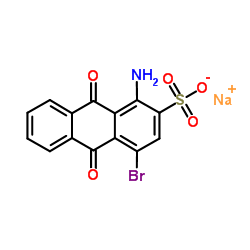1-氨基-4-溴蒽醌-2-磺酸钠

1-氨基-4-溴蒽醌-2-磺酸钠结构式

|
常用名 | 1-氨基-4-溴蒽醌-2-磺酸钠 | 英文名 | 1-amino-4-bromoanthraquinone-2-sulfonic acid sodium salt |
|---|---|---|---|---|
| CAS号 | 6258-06-6 | 分子量 | 404.168 | |
| 密度 | N/A | 沸点 | N/A | |
| 分子式 | C14H7BrNNaO5S | 熔点 | >300 °C(lit.) | |
| MSDS | 中文版 美版 | 闪点 | N/A | |
| 符号 |

GHS07 |
信号词 | Warning |
|
Degradation of bromamine acid by nanoscale zero-valent iron (nZVI) supported on sepiolite.
Water Sci. Technol. 66(12) , 2539-45, (2012) Sepiolite, a natural nano-material, was chosen as a carrier to prepare supported nanoscale zero-valent iron (nZVI). The effects of preparation conditions, including mass ratio of nZVI and activated sepiolite and preparation pH value, on properties of the supp... |
|
|
Convergent synthesis of the potent P2Y receptor antagonist MG 50-3-1 based on a regioselective Ullmann coupling reaction.
Molecules 17(3) , 2599-615, (2012) MG 50-3-1 (3, trisodium 1-amino-4-{4-[4-chloro-6-(2-sulfophenylamino)-1,3,5-triazin-2-ylamino]-2-sulfophenylamino}-9,10-dioxo-9,10-dihydroanthracene 2-sulfonate) is the most potent and selective antagonist (IC₅₀ 4.6 nM) for "P2Y₁-like" nucleotide-activated me... |
|
|
[Treatment of bromoamine acid wastewater by combined ALR-BAC process].
Huan Jing Ke Xue 30(10) , 2930-5, (2009) Combined ALR-BAC was used to treat bromoamine acid wastewater. The results showed that the ALR system could run steadily for over 1 months at the BAA concentration 650 mg x L(-1) after one-month acclimation, the decoloration rate of BAA was reached to about 9... |
|
|
[Degradation characteristics of bromoamine acid by Sphingomonas sp. FL].
Huan Jing Ke Xue 29(9) , 2618-23, (2008) A bacterial strain that could degrade bromoamine acid (BAA) as the sole carbon source was isolated. It was identified as Sphingomonas sp. based on 16S rRNA gene sequence analysis and physio-biochemical characteristics. Under the optimal growth conditions, wit... |
|
|
Rapid and efficient microwave-assisted copper(0)-catalyzed ullmann coupling reaction: general access to anilinoanthraquinone derivatives.
Org. Lett. 9(7) , 1271-4, (2007) [structure: see text]. The synthesis of anilinoanthraquinones 3a-z was achieved by a new, Cu(0)-catalyzed, microwave-assisted Ullmann coupling reaction of bromaminic acid (1) with aniline derivatives 2a-z in phosphate buffer. Good to excellent isolated yields... |
|
|
Bioaugmentation of bromoamine acid degradation with Sphingomonas xenophaga QYY and DNA fingerprint analysis of augmented systems.
Biodegradation 17(1) , 83-91, (2006) One high-effective bromoamine acid (1-amino-4-bromoanthraquinone-2-sulfonic acid, BAA) degrading strain was isolated previously with the ability to use BAA as sole source of carbon and nitrogen. It was identified as Sphingomonas xenophaga QYY by 16S rDNA sequ... |
|
|
Microbial community dynamics in bioaugmented sequencing batch reactors for bromoamine acid removal.
FEMS Microbiol. Lett. 246(1) , 143-9, (2005) Sphingomonas xenophaga QYY with the ability to degrade bromoamine acid (BAA) was previously isolated from sludge samples. The enhancement of BAA removal by strain QYY in sequencing batch reactors (SBRs) was investigated in this study. The results showed that ... |
|
|
Inactivation of yeast hexokinase by Cibacron Blue 3G-A: spectral, kinetic and structural investigations.
Biochem. J. 300 ( Pt 1) , 91-7, (1994) Yeast hexokinase, a homodimer (100 kDa), is an important enzyme in the glycolytic pathway. Although Cibacron Blue 3G-A (Reactive Blue 2) has been previously shown to inactivate yeast hexokinase, no comprehensive study exists concerning the nature of interacti... |
|
|
Combined MBR with photocatalysis/ozonation for bromoamine acid removal.
Appl. Biochem. Biotechnol. 159(3) , 664-72, (2009) A combined biological (augmented membrane bioreactor (MBR)) and photochemical (photocatalysis and ozonation) treatment has been proposed for bromoamine acid (BAA) removal in dyeing wastewater. It was demonstrated that the color and chemical oxygen demand remo... |